Abstract
Conducting an organizational analysis is an integral part of business research, allowing not only a deeper look into a company’s internal culture but also a closer look into its external sphere of influence. Standardized tools of such analysis have been evaluated by time and the experience of various brands, so they can easily be extrapolated to a specific company. This paper proposes using Beyond Meat, Inc., a company engaged in producing and distributing plant-based products that mimic meat and sub-meat, for strategic study. The choice of such a company is not accidental: Beyond Meat, Inc. has exhibited high capital volatility in recent years, including the value of its issued shares (Yahoo!, 2022). In the following sections of this analysis, the current vision and mission of the company, a strategic analysis performed with SWOT and TOWS, a study of the current business model of Beyond Meat, Inc., and the competitive strengths of the brand are offered for study. Thus, this paper aims to bring together the various components of strategic analysis to take a deeper look at Beyond Meat, Inc.
Brief Background Information: Beyond Meat, Inc.
Beyond Meat, Inc. is a modern American company dedicated to the production and marketing of plant-based products made as an alternative to meat food. The company was launched in 2009 through the efforts of Ethan Brown and almost immediately went through its first rounds of funding from major companies such as Facebook and Tyson Foods (Darmiento, 2020). For the first few years, Beyond Meat, Inc. executives set up operations and production and did not enter the retail market until 2013. Since then, the company’s customer spectrum has expanded significantly: it now includes not only individual customers consuming products through retail stores but also large restaurant chains, including Carl’s Jr. and Dunkin Donuts (Darmiento, 2020). Partnering with restaurants allows the brand to increase awareness and restaurants to offer customers a diverse menu based on their preferences.
Regarding Beyond Meat, Inc., it is fair to say that the main products produced include plant-based products designed to replace meat. Customers in stores or restaurants can buy plant-based stuffing, plant-based cutlets, and other forms of items that may visually look like meat. This was not unheard of because one of the values that Beyond Meat, Inc. adheres to is the desire to contribute to environmental protection. In this sense, such a strategy does not seem unreasonable since recently published evidence suggests that the mass production and consumption of red meat pose severe environmental risks for the future (González et al., 2020). According to statistics, the meat and dairy industry cumulatively produces up to 14.5% of all manufactured greenhouse gas emissions each year (Vetter, 2020). For this reason, switching to plant-based raw materials, combined with the potential biogenic cataclysms affecting livestock grazing efficiency, could be an excellent alternative for the food industry. Strictly speaking, concern for reducing greenhouse gas emissions is not the only goal of Beyond Meat, Inc. According to the UN, the second goal of sustainable development is zero hunger (UN, 2022). Accordingly, plant-based food increases the availability of food, which means the brand is doing its part in the fight against hunger. It is worth noting that no one is currently talking about a complete switch to plant-based raw materials, but instead, Beyond Meat, Inc. offers an adequate alternative for all those customers who are concerned about environmental health and are willing to invest in providing it in this way.
The manufacturing processes at Beyond Meat, Inc. involve the selection of plant-based raw materials and further manipulation to create a delicious and visually appealing product. It is stated that the company’s primary sources of raw materials are beans, peas, rice, and vegetable oils (Beyond Meat, n.d.). The manufacturing processes essentially mimic those that already exist in nature in, for example, cattle. Specifically, engineers at Beyond Meat, Inc. extract proteins from plant material using proprietary technology, then build them into a robust three-dimensional matrix that mimics the protein configuration in a meat product. The addition of coconut oil to the vegetable raw material helps replicate the fatty marbling of the meat, while natural colorings and flavorings are used to give the product color and flavor indistinguishable from meat.
Elements of the Brand
Like any other modern and conscious brand, Beyond Meat, Inc. has its vision, mission, and values. The company’s mission statement states that “by shifting from animal to plant-based meat, we can positively affect the planet, the environment, the climate and even ourselves. After all, the positive choices we make every day-no, matter how small-can have a great impact on our world” (Beyond Meat, 2019a). It is not hard to see that the main focus of this statement is on improving the environmental well-being of the brand, which means that the main goal that Beyond Meat, Inc. sees for itself and that the company wants customers to see is caring for the environment. Indeed, such sayings can delight audiences and create a positive brand image. Nevertheless, to improve this statement, a few statistics could be added, especially since the company has something to impress the customer with. Specifically, Beyond Meat, Inc. creates 90% less greenhouse gas emissions, consumes 46% less energy and 93% less land, and 99% less water than the meat industry (CSS, 2018). Based on the mission statement, the values of this brand can be postulated: respect for nature, protecting, promoting, and expanding accessibility, as well as innovation and research (SEC, 2019). Finally, a vital vision of the company is to be able to seamlessly create and market plant-based meats that could replace classic meat products and help protect the environment. As can be seen, the brand elements of Beyond Meat, Inc. look impressive but are insufficiently framed in terms of strategic goals. They do not indicate a focus on the brand’s customers, increasing their loyalty, or improving production techniques; in other words, the company’s main goals revolve around improving the well-being of the environment. While this is a noble goal, it may not be apparent to the potential customer why they should benefit from the company and what short-term benefit they will get from it.
New Brand Elements
For the above reason, it is recommended that the elements of Beyond Meat, Inc. be slightly refined so that their strategic impact is more significant. The following subsections of this section suggest paying attention to the individual components of the redesigned brand mission based on the suggested guidelines and strategic vision for Beyond Meat, Inc. The revised mission, shaped according to the following nine components, is expected to improve company recognition and increase customer engagement and loyalty.
Customers
The actual customers of Beyond Meat, Inc. should be considered people whose food preferences come down to plant-based choices. Strictly speaking, these are vegetarians and vegans who eschew meat products for moral, religious, and other reasons. However, it is worth clarifying that not every vegan will want to become a customer of a company that imitates meat products. The visual similarity can be discouraging to skeptical consumers. In addition, the company’s potential customers are also people who are willing to experiment with food. For the latter, the Beyond Meat, Inc. brand may partner with restaurant chains that offer guests a choice of alternatives to classic red meat. In fact, based on data from a nearly six-month Beyond Meat, Inc. study, it was shown that 93% of Beyond Burger customers are meat-eaters (Pevreall, n.d.). Thus, the company’s customers should include individual consumers as well as retailers (stores, restaurants), which should be reflected in the brand mission statement.
Products
Beyond Meat, Inc. invests in the development of innovative technologies to transform vegetable raw materials into products that mimic the taste, smell, and appearance of meat food. These plant-based products are the company’s essential products. According to the official website, this includes sausages, sausage, stuffing, burgers, meatballs, and jerky products made entirely from plant-based materials. In the current brand mission statement, the entire product set is summarized by the term “plant-based meat,” which does not really reflect the variety of what the company offers the customer.
Markets
Beyond Meat, Inc. is much bigger than it may seem at first glance. According to official figures, Beyond Meat, Inc. products are distributed directly or indirectly to more than 130,000 affiliates worldwide (SEC, 2021). This includes tens of thousands of restaurants and grocery stores in the United States, about thirty thousand stores outside the country. The global nature of the U.S. company is one of the hallmarks that makes Beyond Meat, Inc. a virtually international brand. Given the influential nature of this data, it seems surprising that it has not been communicated in the organization’s mission statement.
Technology
Beyond Meat, Inc. can safely be considered technologically advanced and modern, given its engineering capabilities for plant-based meats. The brand’s financial statements report that Beyond Meat, Inc. invests up to 24% of its total operating expenses in the Research & Development (R&D) area, which implies that for the organization to maintain its image as one of the innovative leaders in the field is an important differentiator (SEC, 2021). It is for this reason that the high technological modernity of the brand must be postulated in the mission statement.
Caring for Financial Growth
As with any organization, for Beyond Meat, Inc. caring for financial well-being and sustained growth is not an afterthought. The company is actively expanding and developing technology in order to improve operational capabilities, which in turn affect earnings growth. According to financial statements (Figure 1), by 2021, the company was showing steady growth in total revenue, which means this metric is necessary and relevant to the organization’s management.
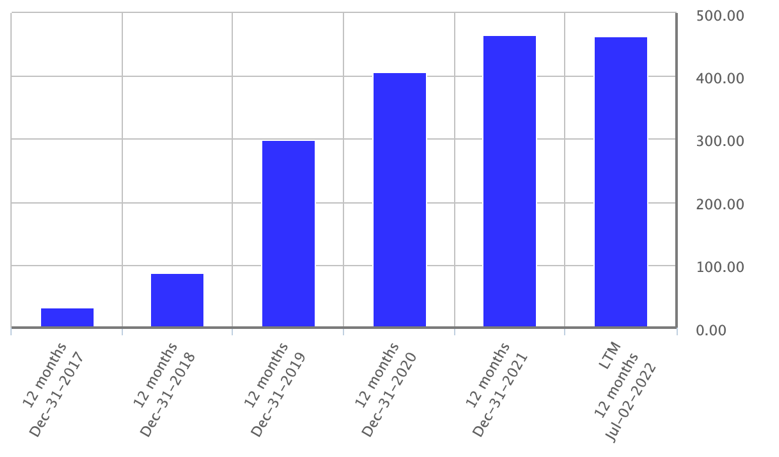
Philosophy
At the core of Beyond Meat, Inc.’s philosophy is a commitment to caring for the environment and creating products and technology that are designed to protect the planet overall. It is this philosophy that is the core of the brand values; it is this philosophy that reflects the essence of Beyond Meat, Inc. The current mission statement reflects the brand philosophy correctly, so it does not seem necessary to change it.
Self-Concept
The company’s main competitive advantage is its direct impact. To date, Beyond Meat, Inc. has developed a vast base of loyal customers, private and retail, around the world. This influence helps Beyond Meat, Inc. establish itself in an industry niche and compete effectively. Much of this advantage has been made possible by the company’s focus on technological development and innovation, as well as its emphasis on environmental awareness, which is relevant in public discourse today (Dahmm, 2021). Thus, the self-concept of Beyond Meat, Inc. is oriented around the company’s unique balance of technical sophistication combined with a noble, as the audience might think, fundamental message.
Concern for the Public Image
The same mission statement of Beyond Meat, Inc. emphasizes an agenda that is critically relevant to today’s society. From this fact alone, one can conclude that the company’s public image is significant to the company. Beyond Meat, Inc. is actively developing a customer loyalty system, creating a visually appealing website, and actively collaborating with opinion leaders, including Kim Kardashian (Zackai, 2022). It follows that the public image is critical to Beyond Meat, Inc. today, which is justified by its actions and marketing strategies.
Caring for Employees
For companies that are multinational, it is not uncommon for subordinate employees to be poorly managed. The best way to determine the adequacy of employee care measures is to look at their actual feedback on their work experience. The Indeed website reports that management problems faced by Beyond Meat, Inc. include a lack of understanding of strategies by management, pressure, disorganization, and high employee turnover (Indeed, 2022). The main focus of most of the negative feedback was on ineffective management that had no strategies or hierarchy. Thus, even though Beyond Meat, Inc. may talk about how it values its employees, in reality, it is not entirely true.
Bottom Line Mission
Given the evidence described above, the brand mission of Beyond Meat, Inc. can be rewritten to meet all the criteria. The new mission would look as follows: “We, Beyond Meat, create innovative plant-based food products that do not taste any different than meat food but have a significant positive effect on the environment by reducing up to 90% of greenhouse gas emissions. Considering the value of our employees and international customers, we are committed to increasing the environmental benefits and availability of healthy alternatives.
Business Model Analysis
In general, the business model of any company should be understood as the operating mechanisms that allow the company to generate profits. However, as Figure 2 shows, the company’s net income has been declining in recent years, despite an increase in overall revenues. As a consequence, this may be one indication that the business model is ineffective for the company. This section offers a critical examination of the business model of Beyond Meat, Inc. with a definition of how the brand makes money.
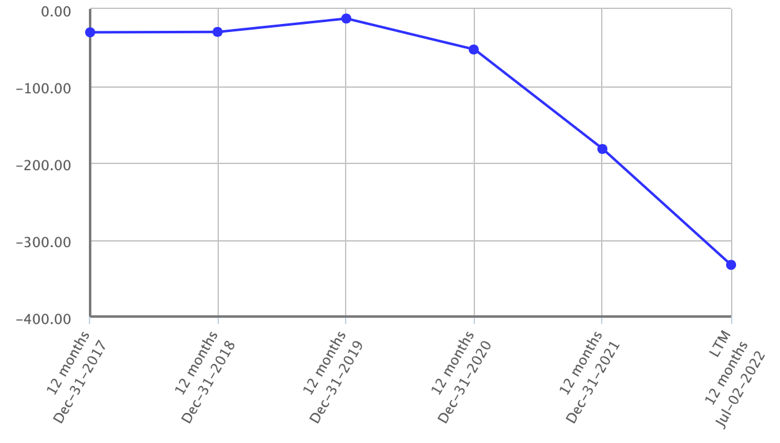
The plant-based products that the company produces and sells are created based on chicken, pork, or beef, which increases the positional diversity of Beyond Meat, Inc. Based on the technology already described, the organization creates two types of products, namely fresh and frozen, depending on the needs of the end customer and the transportation distance of the products. Regardless of the type of product, Beyond Meat, Inc. promises that the composition of each product is all-natural and excludes any artificial additives or GMOs (Beyond Meat, 2019b). Finished products are delivered through multiple distribution channels to the end consumer, whether it is a grocery store or a restaurant. Among the U.S. retailers where Beyond Meat, Inc. products can be purchased directly are some of the largest chains, such as Walmart, Target, Kroger, and Whole Foods, with the company constantly expanding its number of affiliate branches. Notably, most of the revenue (except in 2019) was generated from retail stores compared to restaurant chains, as shown in Figure 3.
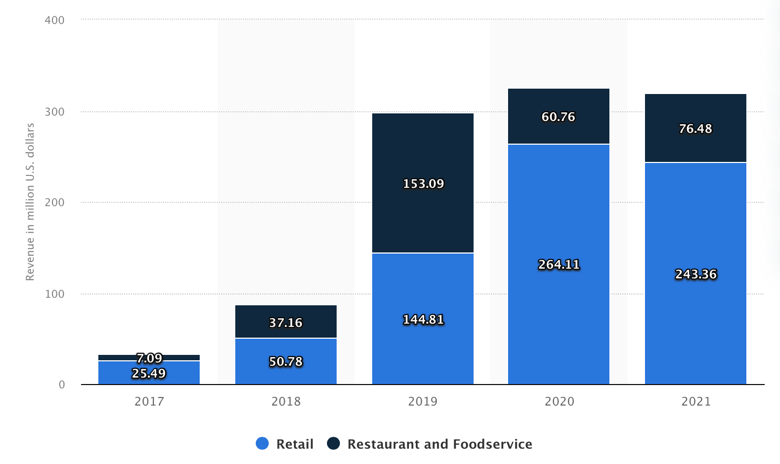
It is worth specifying that the segments of foreign markets in which Beyond Meat, Inc. is present are also expanding. The points of concentration for Beyond Meat, Inc. products are the United States, the Netherlands, and China, which together account for up to 794,000 square feet of the company’s production capacity (SEC, 2021). However, the company’s primary consumer continues to be the U.S. resident. Figure 4 shows that up to 68.8% of the company’s customers in 2021 were U.S. residents, with only about one-third (31.2%) coming from foreign markets. Notably, this share of foreign markets has gradually increased (except for 2019) over the past five years. In other words, one can conclude that Beyond Meat, Inc. has bet on geographic expansion into new regions in order to generate more profits.
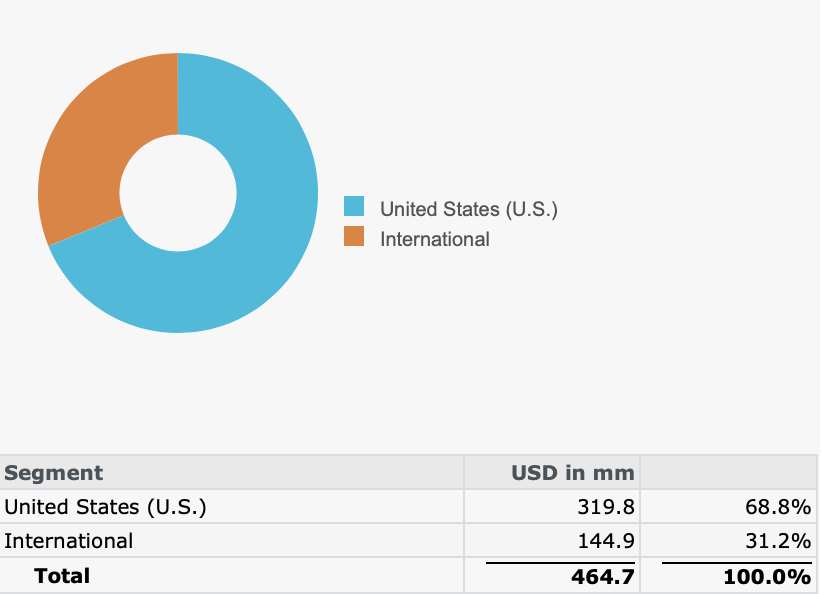
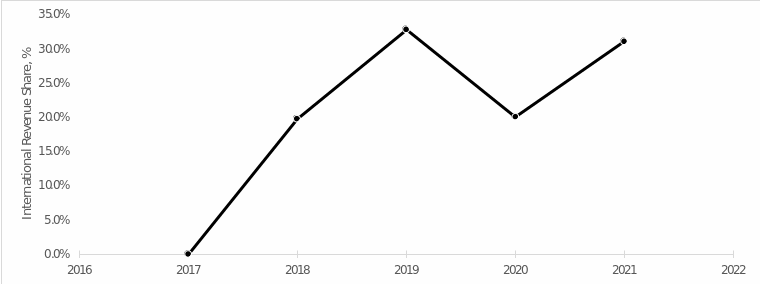
To discuss the complete picture of Beyond Meat, Inc.’s business model, we should look at the company’s logistical arrangements. The company reports that one of the main ingredients in its products is vegetable protein, which, according to its financial statements, the brand purchases from suppliers such as Roquette and Puris Proteins, LLC (SEC, 2021). In addition to plant-based raw materials, the company also purchases natural additives, whether beet pigments or flavorings, as well as vitamins and minerals. Since these raw materials are not in short supply, terminating a partnership with one of the suppliers would not put severe pressure on the company, which implies that the supply chain at Beyond Meat, Inc. is protected from the contingency. Proof of this can be seen in the nearly 80% increase in revenue in the second quarter of 2020, when the global pandemic disrupting coordination routes had just begun, compared to the first quarter of the same year (SEC, 2021). The company extracts the raw materials and synthesizes them into a three-dimensional matrix using proprietary technology. The essence of the process does not change between production factories, which means the same technology is sold in the U.S., the Netherlands, and China. Finished products are distributed to retail branches and stores with the help of transport companies in refrigerators to increase shelf life.
SWOT and TOWS Analysis
To think critically about the commercial operations of Beyond Meat, Inc., it is necessary to refer to the company’s SWOT analysis. In this section, only the general conclusion for the SWOT analysis is offered for study; the matrix is shown in Appendix A. The main conclusion of this analysis implies that Beyond Meat, Inc. has a large number of strengths that allow the company to stay in the market and strengthen its influence. That said, the weaknesses are also significant: they include low position offerings, financial regressions, and the use of unhealthy coconut oil in product formulations. If weaknesses are not adequately managed, Beyond Meat, Inc. runs the risk of significantly diminishing its reputation appeal because it is sensitive. Critical areas of brand opportunity should include comprehensive expansion, technological, geographic, and positional. Such expansion, however, can inevitably lead to heavier supply chains, affecting the company’s profits and reputation, especially in the face of depressing competitive growth and natural and geopolitical crises. Thus, a company should invest in effective management that can overcome weaknesses.
A TOWS matrix based on SWOT is shown in Appendix B. This matrix shows how to use the company’s current capabilities and strengths as strategies in order to minimize any risks. Key strategies that have been discovered using TOWS include leveraging existing influence and collab experience, as well as engineering and technological expansion in order to resist market pressures more effectively. Notably, paramount to all strategies is modifying the corporate culture in which employees do not understand their management (Indeed, 2022). Therefore, it is expected that since Beyond Meat, Inc. is able to establish management, it will favorably affect other areas of development as well.
SWOT Analysis
Strengths
- Using only natural ingredients to make products.
- Strong constructed influence.
- Patented manufacturing technology: the company can expect these processes to be legally protected against copying during the life of the patent (Sachs, 2018).
- Experience with major global brands and celebrities (Zackai, 2022).
- Focus on the current environmental agenda (Dahmm, 2021)
- The company’s IPO in 2019: share price rose more than 352% in just three months (Yahoo!, 2022).
- Good employee salaries (Indeed, 2022).
- Attractive marketing increases sales (Xia et al., 2020).
Weaknesses
- Stereotypes about veganism distract potential customers (De Groeve et al., 2021).
- Low employee management (Indeed, 2022).
- Excessive concentration in the U.S.: low presence in foreign markets (Sehmbi, 2021)
- Limited positional offerings reduce the range of potential customers.
- Using coconut oil in the formulation has been shown to cause gastrointestinal disorders and the development of cardiovascular abnormalities (Healthline, n.d.).
- Annual drop in net income (SEC, 2021).
- Falling stock price by more than seven times in one year (Yahoo!, 2022).
- Infrequent lawsuits against the company affect public appeal (Rabb, 2022).
Opportunities
- Expansion of engineering and technology base (Marr, 2021).
- Expansion into foreign markets (Sehmbi, 2021)
- Expected expansion of healthy plant-based nutrition trend (Minassian, 2022).
- Expansion through increased operating expenses (SEC, 2021).
- Development of additional product lines.
- Finding new ingredients for plant-based meats besides coconut oil (Healthline, n.d.).
- Developing a corporate culture of adequate and effective management (Indeed, 2022).
- Expanding marketing strategy to combat stereotypical thinking and enhance reputation (De Groeve et al., 2021).
Threats
The impact of geopolitical and humanitarian crises (Orhan, 2022).
Growing competition causes stress (Zgarni & Lamia, 2019).
Natural disasters affect plant yields (Middleton et al., 2019).
Supply chain disruptions in the foreign expansion (Silvestre et al., 2018).
The exit of key investors raises concerns (Shaffer, 2019).
Falling profits due to legal costs (Rabb, 2022).
The need for frequent discounts to attract audiences affects operating profits.
Close association with opinion leaders can destroy a company’s reputation (Zackai, 2022).
TOWS Analysis
Group Map
Two axes were used to create a group map of competitors: market coverage and a number of position offerings. It is stated that by 2022, the global plant meat market is $7.9 billion; accordingly, the share of the largest competitors was determined by their annual revenues for 2021 (MRR, 2022). The number of position offerings was determined by manually counting active positions on each competitor’s official website. A group map was constructed from this data (Figure 6). It can clearly be seen that Beyond Meat, Inc. occupies one of the leading positions in the industry, with up to 5.5% of the total global market. The company’s equal positioning competitor is Maple Leaf Foods, which, however, has about a tenfold difference in market share. In fact, Maple Leaf Foods is a conglomerate comprising a collection of brands, which explains such a high difference (Maple Leaf, 2022). Impossible Products has the most offerings, but that company’s share of the industry market is significantly smaller. Thus, Beyond Meat, Inc. occupies a strong position within the line of world leaders. The method of focusing directly on the industry as a whole, rather than on an individual product, was due to the low positional diversity in the industry due to its novelty to the international community.
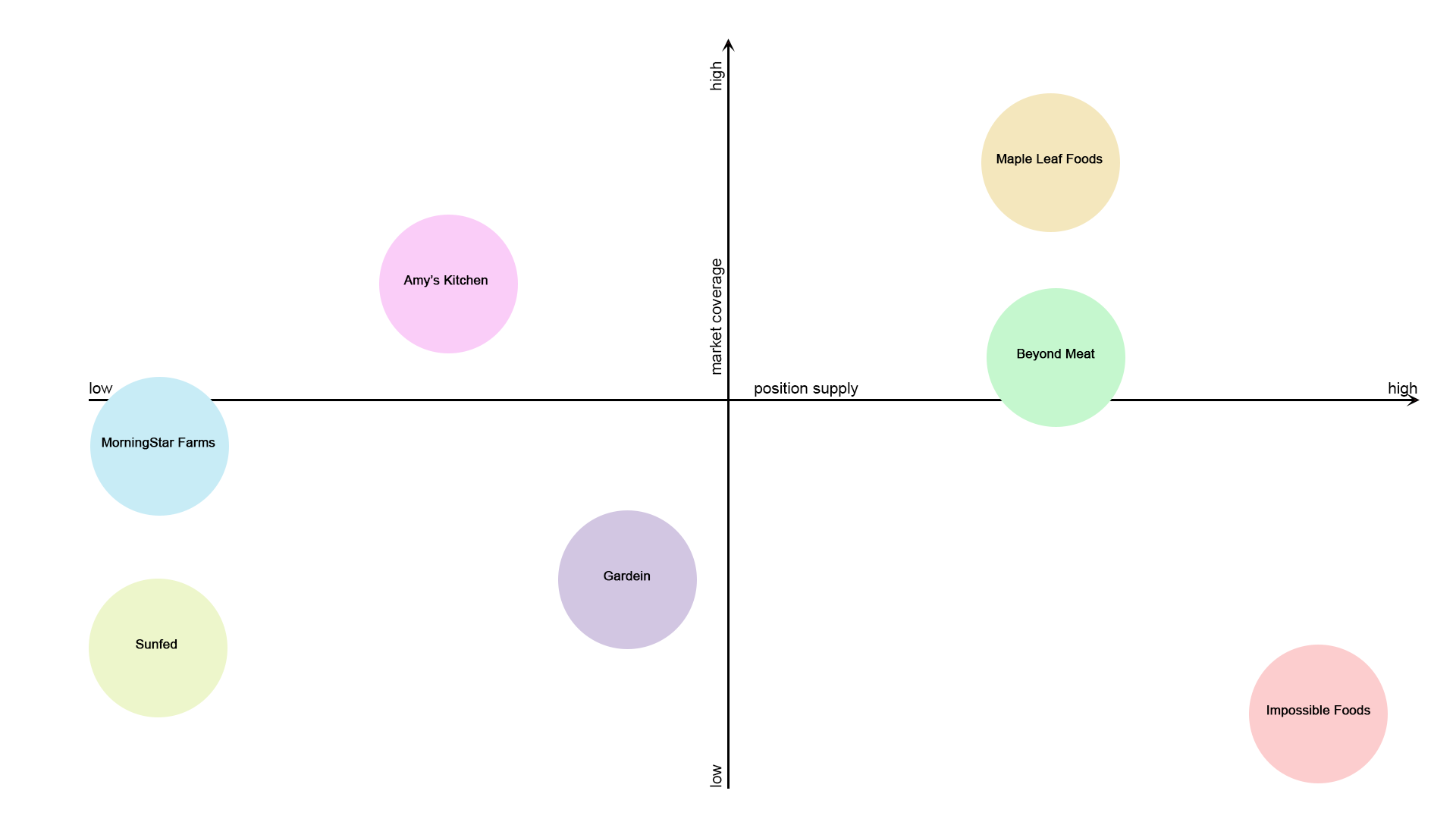
Competitive Analysis
PESTLE
Appendix C shows the PESTLE macro-media analysis performed for Beyond Meat, Inc. As the PESTLE shows, Beyond Meat, Inc. is severely constrained by political and legal regulations that have a direct impact on the brand’s operational performance. Although the company has chosen the path of least resistance, in which it markets its products in areas that are favorable to the economy and the environment, there is no guarantee that national governments will not tighten controls. In terms of social and environmental criteria, the company is experiencing a favorable condition because it is hitting the trends. Since plant-based meats are modern technologies, Beyond Meat, Inc. also finds itself forced to be innovative, which in turn can positively impact consumer loyalty.
Political
- Increased taxes and regulations will have a destructive effect on business welfare.
- Relaxing taxes and regulations would positively affect business welfare.
- Governments can impose carbon caps on businesses (Patnaik, S. & Kennedy, 2021).
Economic
- The increase in demand for vegetable meat will be favorable for the company.
- An increase in inflation will entail an increase of purchase prices for raw materials and an increase of final prices for the consumer.
- Dealing with foreign production at the exchange rate depends on the volatility of these currencies.
- The global industry is expected to grow by 2027 (MRR, 2022).
- As a consequence, growing competition puts pressure on the company.
Social
- The trend toward veganism positively affects demand (Eswaran, 2018).
- Existing stereotypes about veganism can reduce the potential customer base (De Groeve et al., 2021).
Technological
- Patented technology protects company interests (Sachs, 2018).
- Increased R&D spending reflects a focus on business innovation.
- The site’s external visual appeal and technical sophistication demonstrate a high awareness of the company.
Legal
- As a food organization, a company must respect consumer rights and enforce food safety standards (Gardner, n.d.).
- Using coconut oil may not be an appropriate practice (Healthline, n.d.).
- Managing employees includes strict compliance with labor laws.
- The need to resolve lawsuits can decrease a company’s operational efficiency (Rabb, 2022).
- The use of advanced marketing techniques positively affects demand.
Environmental
- The trend toward environmental protection positively influences demand.
- Focusing on the beneficial effects on nature positively influences customer loyalty (Dahmm, 2021).
- Mass cultivation can raise concerns about soil scarcity and fertilizer use (Lin et al., 2019).
Porter’s Five Forces
Appendix D shows Porter’s Five Forces analysis: in general, the totality of all threats can be considered moderate. Thus, the threats of substitution and customer strength are classified as high since goods can be replaced almost without problems, and the company is often forced to discount. The entry of new players into the market also shows a high threat since similar technologies can be replicated without infringing on patent rights. At the same time, supplier power is low because the company can relatively easily find a new supplier if the current one leaves since plant raw materials are not unique. Competition in the industry is moderate because few companies are represented, and Beyond Meat, Inc. is one of the world leaders in the business.
Competition in the industry
This industry is relatively young and developing, so the competition is not fierce. Beyond Meat, Inc. has already managed to get into the top three world leaders, so it will not be under pressure from competitors with low parameters. Nevertheless, key competitors continue to develop, putting pressure on the company. In other words, the threat of competition to the market is moderate.
Potential of new entrants into an industry
Although plant-based meat technologies are specific, they are substitutable. It is relatively easy for new players to enter the new industry and produce similar products. In other words, the threat of new players entering the market is high.
Power of suppliers
The plant-based raw materials used to make Beyond Meat, Inc. products are not unique. This means that the departure of any of the company’s suppliers would not be a significant blow since management would be able to choose another supplier. In other words, supplier strength is low.
Power of customers
Customers may not choose to buy such a specific product, causing the company to lower prices and offer discounts to realize at least some sales (Stapleton, 2022). It is also difficult for the company to search for new customers because experimental products may scare them away. In other words, customer power is high.
Threat of substitutes
Beyond Meat, Inc. does not produce a unique, indispensable product because competitors already use plant-based meat technology. The company currently holds a patent on creating structured matrix proteins that replicate the configuration of meat-it cannot be substituted. However, from the consumer’s point of view, a particular technology may be of little interest to them if it does not affect the unique organoleptic properties. For this reason, the threat of substitution is high.
References
Thompson, A., Peteraf, M., Gamble, J., & Strickland, A. (2022). Crafting & executing strategy: The quest for competitive advantage: Concepts and cases. McGraw Hill.
González, N., Marquès, M., Nadal, M., & Domingo, J. L. (2020). Meat consumption: Which are the current global risks? A review of recent (2010–2020) evidences. Food Research International, 137, 1-9. Web.
Vetter, D. (2020). Got beef? Here’s what your hamburger is doing to the climate. Forbes. Web.
UN. (2022). Do you know all 17 SDGs? United Nations. Web.
Darmiento, L. (2020). Ethan Brown went vegan but missed fast food. So he started a revolution. LA Times. Web.
Beyond Meat. (n.d.). Yes, it’s meat made from plants. Beyond Meat. Web.
Yahoo! (2022). Beyond Meat, Inc. (BYND). Yahoo! Finance. Web.
Beyond Meat. (2019a). Our mission. Beyond Meat. Web.
CSS. (2018). Beyond Meat’s beyond burger life cycle assessment: A detailed comparison between a plant-based and an animal-based protein source. Center for Sustainable Systems. Web.
SEC. (2019). Beyond Meat, Inc. Securities and Exchange Commission. Web.
SEC. (2021). Beyond Meat, Inc. Securities and Exchange Commission. Web.
Zackai, S. (2022). Kim Kardashian is featured in a new campaign by Beyond Meat® as the company’s first chief taste consultant. Beyond Meat. Web.
Indeed. (2022). Beyond Meat. Indeed. Web.
Beyond Meat. (2019b). Beyond burger. Beyond Meat. Web.
Wunsch, N.-J. (2022). Global revenue of Beyond Meat, Inc. by sales channel 2017-2021. Statista. Web.
Pevreall, K. (n.d.). 93% of people buying the beyond burger are meat eaters. Live Kindly. Web.
Dahmm, H. (2021). Major environmental data gaps remain, but progress is on the horizon. Trends. Web.
Healthline. (2022). Can a coconut oil detox help me lose weight and more? Healthline. Web.
Xia, H., Pan, X., Zhou, Y., & Zhang, Z. J. (2020). Creating the best first impression: Designing online product photos to increase sales. Decision Support Systems, 131, 1-7. Web.
Sachs, R. E. (2018). The uneasy case for patent law. Michigan Law Review, 117(3), 499-545. Web.
Sehmbi, N. (2021). Top 6 reasons to expand your business internationally in 2022. WorldFirst. Web.
De Groeve, B., Hudders, L., & Bleys, B. (2021). Moral rebels and dietary deviants: How moral minority stereotypes predict the social attractiveness of veg* ns. Appetite, 164, 1-11. Web.
Rabb, M. (2022). Beyond meat face lawsuits. This may change your next burger order. The Beet. Web.
Marr, B. (2021). The 8 biggest business trends in 2022. Forbes. Web.
Minassian, L. (2022). Why the global rise in vegan and plant-based eating is no fad (30x increase in us vegans + other astounding vegan stats). FR. Web.
Silvestre, B. S., Monteiro, M. S., Viana, F. L. E., & de Sousa-Filho, J. M. (2018). Challenges for sustainable supply chain management: When stakeholder collaboration becomes conducive to corruption. Journal of Cleaner Production, 194, 766-776. Web.
Middleton, N., Tozer, P., & Tozer, B. (2019). Sand and dust storms: Underrated natural hazards. Disasters, 43(2), 390-409. Web.
Zgarni, A., & Lamia, G. (2019). The impact of competition intensity and strategic capabilities on competitive strategic business choices: The case of tunisian manufacturing industries. International Review of Management and Marketing, 9(1), 144-151. Web.
Orhan, E. (2022). The effects of the Russia-Ukraine war on global trade. Journal of International Trade, Logistics and Law, 8(1), 141-146.
Shaffer, E. (2019). Tyson Foods exits investment in Beyond Meat. FBN. Web.
MRR. (2022). Plant-based meat market. Markets and Markets. Web.
Maple Leaf. (2022). A family of brands. MLF. Web.
Gardner, S. (n.d). Consumers and food safety: A food industry perspective. FAO. Web.
Patnaik, S. & Kennedy, K. (2021). Why the US should establish a carbon price either through reconciliation or other legislation. Brookings. Web.
Eswaran, V. (2018). Vegetarianism is good for the economy too. WEF. Web.
Lin, W., Lin, M., Zhou, H., Wu, H., Li, Z., & Lin, W. (2019). The effects of chemical and organic fertilizer usage on rhizosphere soil in tea orchards. PloS One, 14(5), 1-16. Web.
Stapleton, S. (2022). Beyond Meat losses mount on product launches, deep discounts; shares slump. Reuters. Web.
